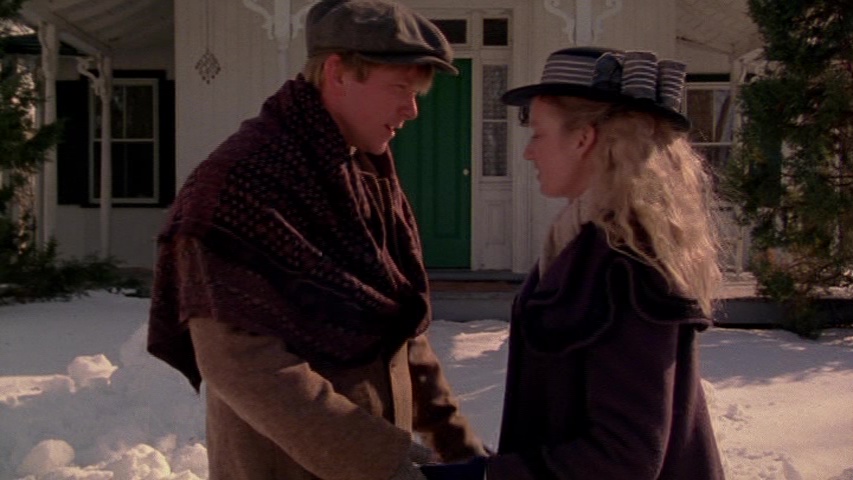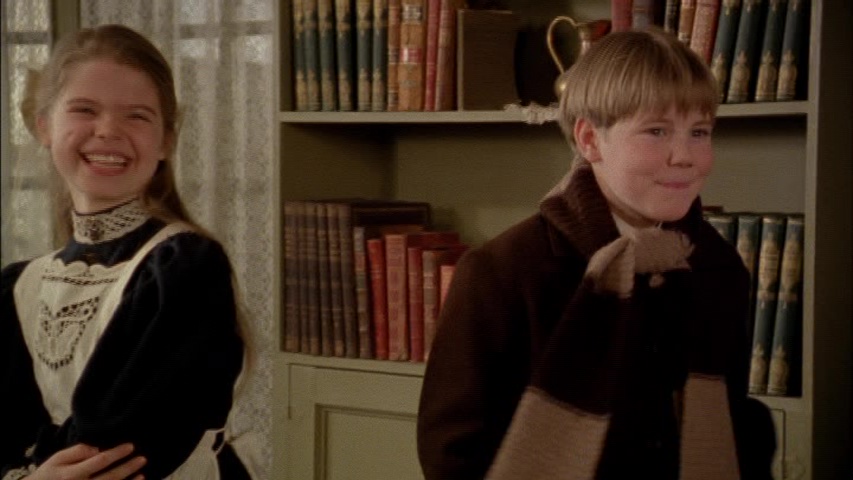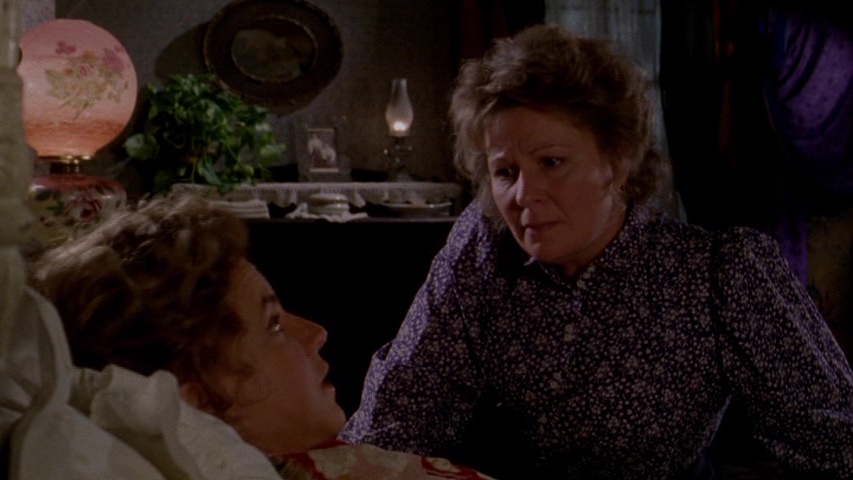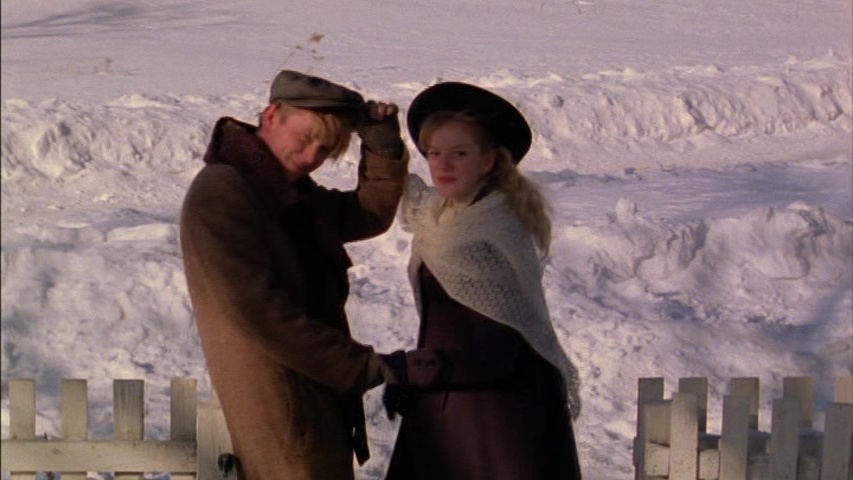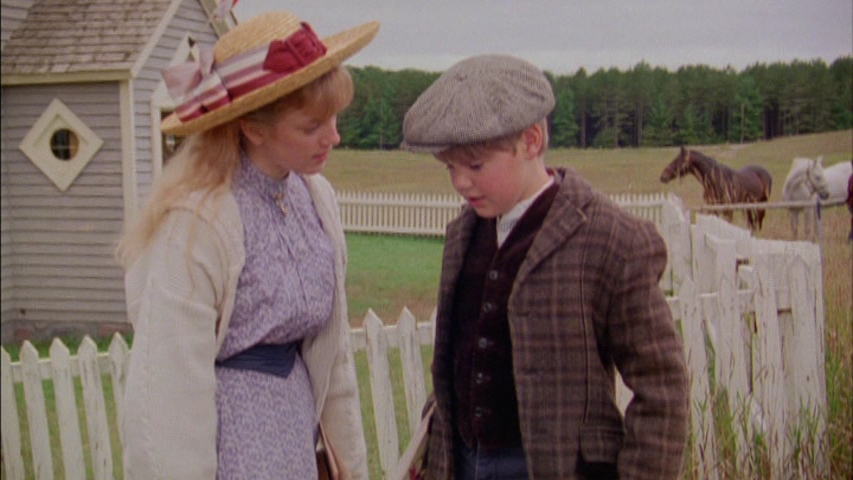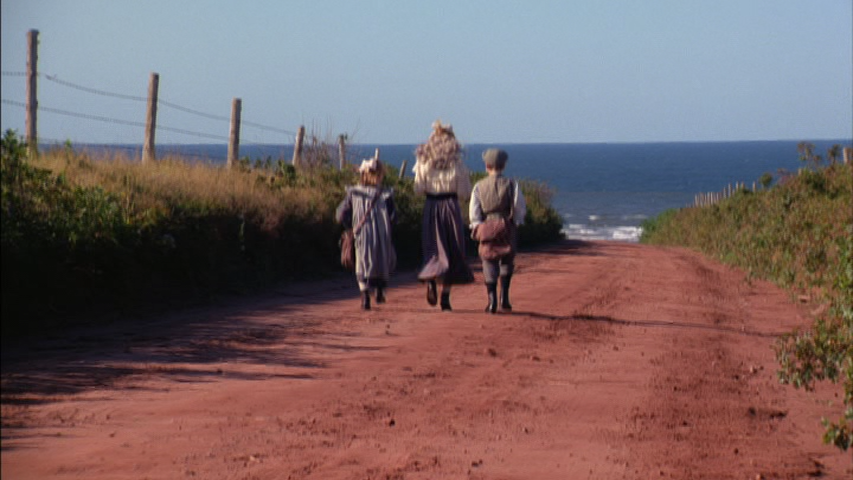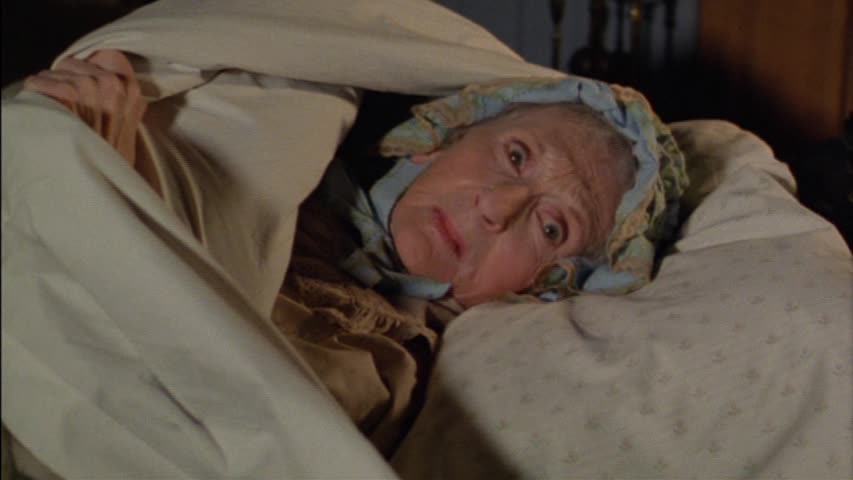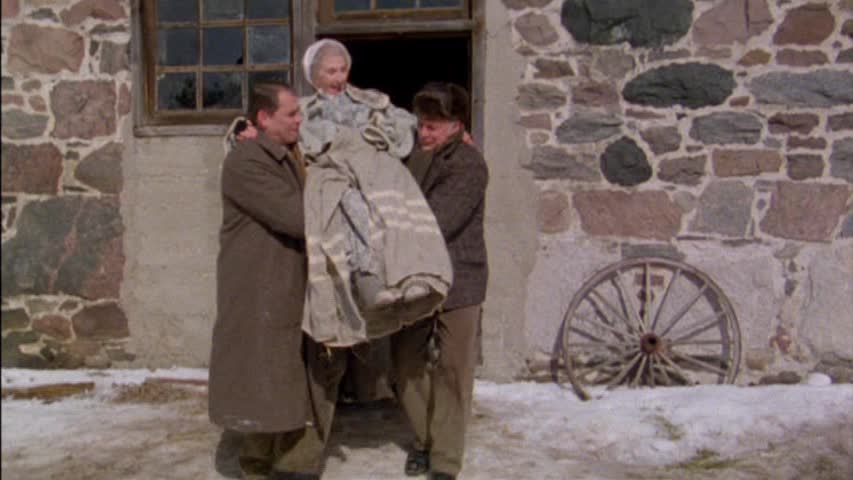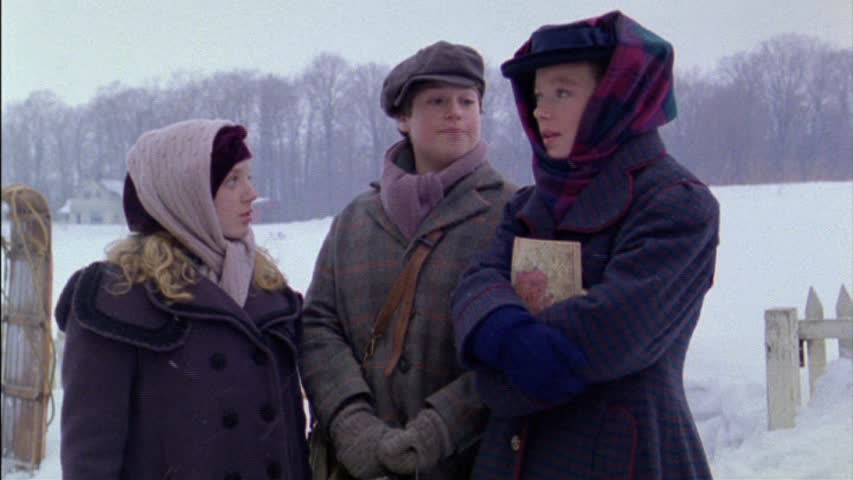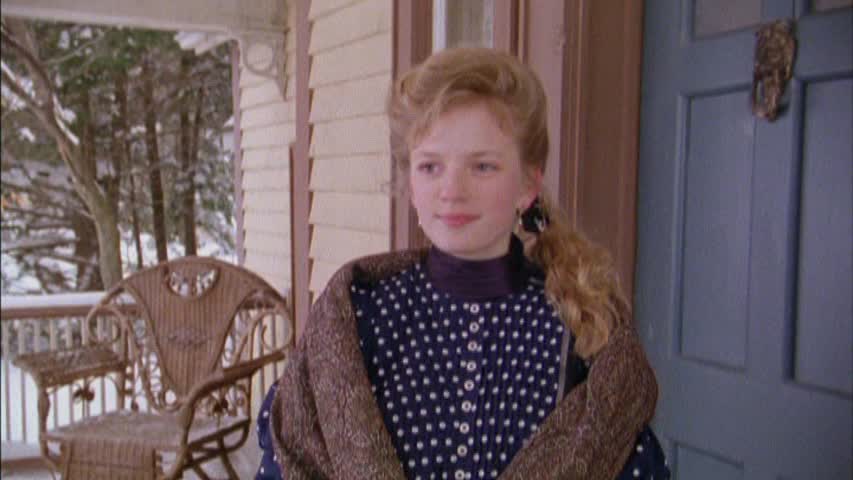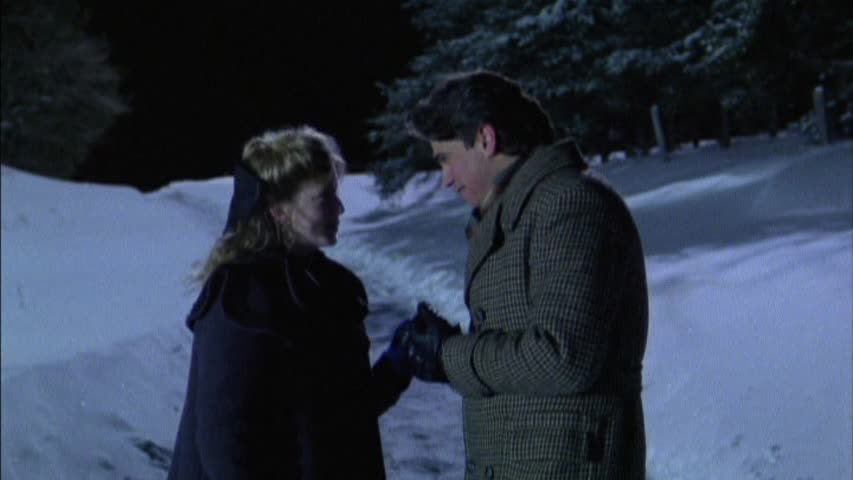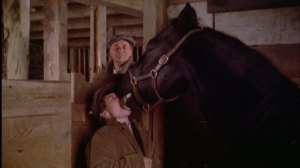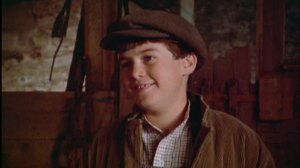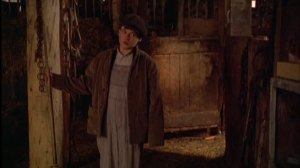Episode Summaries: Avonlea gets a new minister. Reverend John Elliot (Jim Mezon) arrives with his worldly wife Viola (Stockard Channing) and teen son Booth (Jaimz Woolvett). The town’s initial excitement turns to fear when it becomes clear that the Booths aren’t like the typical minister family. John has a penchant for telling jokes during his sermons that almost cross the line. Booth is a rambunctious musician who immediately takes a liking to Sara Stanley, to the chagrin of Hetty. And Viola is a free spirit, not conforming to the conservative standards of the women in town. Janet is drawn to Viola’s worldly ways and the two develop a friendship. With Booth, Sara learns to let loose and be more independent of her Aunt Hetty. Despite Hetty’s initial objections, Sara and Booth develop a relationship and share a couple of kisses along the way. Meanwhile, Janet grows concern at Viola’s casual daytime drinking. At first, Viola is defensive. However, Janet feels guilt for how she confronted Viola when she learns that Viola suffers from chronic pain as a result of a past spinal injury. Ultimately, having lost favor with the town as a whole, John Elliot decides to move his family out of town, closer to the city and closer to a hospital where Viola’s needs can more easily be met. Janet and Sara will both remember their respective friendships with Viola and Booth.
“Enter Prince Charming” was directed by Stephen Surjik and written by Raymond Storey, with music by John Welsman. “The Minister’s Wife” was directed by Allan King and written by Raymond Storey, with music by John Welsman.
My Grade: For most of this post, I’m pretty much going to discuss these episodes as one unit. There are a couple things that separate these episodes. One, is that they have different directors. And two, “Enter Prince Charming” mostly focuses on Sara and Booth, while “The Minister’s Wife” is Stockard Channing’s big Emmy-nominated episode. However, we see enough Viola in the first episode and enough Sara and Booth in the second episode that this whole story is essentially a two-part finale for season 5. Besides the “Parent Trap” episode from season 3, this show does not do official “two-part episodes.” However, there’s clearly a common thread between these final 2 episodes, and that is the Booth family’s experience in Avonlea.
These episodes are, in my opinion, excellent, mainly because of the story. Yes, these episodes feature some of the less flattering threads of the Avonlea fabric. The episode features two “Hollywood” guest stars that nearly take away from the regular characters. As a result, most of regular characters come across as almost one dimension. As an audience, we’re supposed to feel sympathy for Viola, a free-spirit who is ostracized for wearing robes and not keeping her hair up in public. We’re supposed to be on John Elliot’s side when he bravely confronts the church board and tells them that he will not “rein in” his wife and tell her what to do. All the while, the townspeople look like unreasonable, backwards busybodies. We never really see the townspeople’s point of view or get their side of the story. We don’t really understand why Alec King would side with the town. There’s a lot of focus on the Booths, and they are main characters of this movie-length story.
Despite those issues, this is a well-written, well-structured episode that feature great performances by all the actors who make up the Booth family. It’s also nice to see Sara finally get a romance of her own. For the first four seasons, Sara was more a matchmaker than a “story girl.” Season four showed Sara at her most selfless; she’s literally being chided by both Gus and Felicity while desperately trying to save their relationship. Sara also has a “relationship” with a rodeo performer in season four. However, that relationship was completely misguided. It was one-sided. The guy was significantly older. And Sara was left heartbroken in the end. Finally, after five seasons, Sara has an age-appropriate beau of her own. And she’s well matched with Booth. To be honestly, I love the character of Booth, and I love Sara and Booth’s relationship, even if it is short-lived. This episode tries to paint Sara as being hopelessly proper and conservative. That’s not exactly wrong. While Sara was sort of a troublemaker during the earlier seasons, she definitely became more of a stereotypical “lady” by season four. And her experience with the rodeo performer could have probably made Sara even more guarded in regards to love. But this episode definitely exaggerates this aspect in Sara’s personality. It’s clear by now that if Sara wants to do something, she does it, with or without Hetty’s approval. So, it’s not exactly a big deal when Sara sneaks off with Booth to do some Titanic-style dirty dancing. But, again, considering Sara’s been hurt once before by a guy she liked, the fact she can trust Booth is a big step.
Booth is a great character, and I so wish he had become more of a recurring presence in season 5. The thing I like most about Booth is that he brings something new. One of my favorite scenes within these two episodes is when he first visits Sara (with Davey and Dora) without any adult supervision. He introduces Sara to “stride piano,” an early type of jazz style that was, at least, popularized by black musicians. He also dances the “cakewalk” with Sara, a style of dance created within black communities during the mid-19th century. He exposes Sara to these different musical styles while Davey and Dora happily watch from the sidelines. One, it sort of reminds me of our introduction to Gus Pike in season 2 where he plays the fiddle for Felix and Sara while fishing. The joy Sara and Felix felt in that scene mirrors Davey and Dora’s joy when they hear Booth play the piano or watch him dance with Sara. I also like this scene because, let’s face it, Avonlea is very white. Prince Edward Island is still very white. But during the turn of the century, Avonlea would probably not be exposed to black culture. Since the show is very realistic, they can’t shoehorn black characters. But if they did, if a black family moved into town, how would the townspeople react? Clearly, not that well if even the Booths are considered too much. It’s just nice and refreshing when there’s a different aesthetic featured on the show. Before the events of season one, Sara used to travel the world and expose herself to different cultures and communities. Seeing Booth do something different than what she experiences in Avonlea must have harkened Sara back to a time when she was more adventurous. It’s possible that staying in a small town like Avonlea was the best and maybe also the worst thing for her personal development.
And, of course, Sara also has her first kiss. She kisses Booth towards the end of the first part, as well as the end of the second part. Overall, I probably like “Enter Prince Charming” a bit more than “The Minister’s Wife.” “Enter Prince Charming” allowed for a regular character (Sara) to go through some sort of change, while the second episode seemed to be Disney’s attempt at getting another Emmy nomination (and it worked). But, individually, or as a unit, both episodes get an (A) from me.
Spotlight Performances: Since this post technically features two episodes, I get to name two actors. We all know who Stockard Channing is. She’s definitely the most notable guest star from season 5, a season that didn’t have a lot of guest stars. Her breakout role was that of Rizzo in Grease. In 1991, she was nominated for a Tony for her performance in Six Degrees of Separation (an amazing play), and then she received an Oscar nomination for the film adaptation in 1994. The Oscars took place just a few days before this episode aired in Canada and about a month before the US airdate. Stockard Channing, like most of the American guest stars, was very excited to be part of this show, and felt like there was an innocence and freshness in this Canadian show that had long been missing in Hollywood. Besides Six Degrees, Stockard’s other big role was the First Lady in The West Wing. Like mentioned before, Channing received an Emmy nomination for Guest Actress in a Drama. She was also nominated for a CableACE, competing in the Lead Actress category against Jackie Burroughs.
We obviously don’t get to know Viola Elliot too well. We can guess that at some point, Viola was probably the typical, demure minister’s wife. The accident that injured her spine and caused her lifelong, near constant pain probably gave her new perspective on life. She may not be able to control her physical self, but she can at least control how she approaches life mentally. Viola Elliot isn’t a unique character, but in the world of Avonlea, she’s something new. Viola doesn’t set out to change Avonlea. She doesn’t really care what people think of her. But her character shows that sometimes living your own best life, for whatever reason, can bring out the worst in others. Usually, Avonlea celebrates the small town and their values. However, in this case, we see the more judgmental side. Jim Mezon as Viola’s minister husband John Eliot gives my other favorite performance within this two-parter. And the scene when the church board demands that John changes the content of his sermons and reins in his wife is another favorite of mind. I like that John stands by his family and his wife and refuses to succumb to the pressure of this small town. Maybe this is a controversial point, but I am 100% on John side, even if the episode could have done a better job in allowing us to see the human side in the town’s point of view as well. Mezon only has a few screen credits; he most works in theatre.
Favorite Scene: Jaimz Woolvett, as Booth, also gives a great performance in this episode. He’s a Canadian actor, mostly known for his role in Clint Eastwood’s Unforgiven. He was actually initially considered for the role of Gus Pike. But, he chose Unforgiven over Road to Avonlea. I’m going to make the wild assumption that if Woolvett had been cast as Gus Pike, then Gus Pike’s characterization would have been very similar to that of Booth’s. I’ve mentioned some of my favorite scenes in this episode (stride piano, John Elliot defending his wife); however, I have a couple more. During “The Minister’s Wife,” Booth and Sara’s romance sort of becomes the sub-plot to the Viola drama. The story line turns into Hetty butting into Booth and Sara’s relationship every chance she gets. I like the scene where Sara, Booth and Hetty are having dinner together, and Sara serves Booth the funkiest looking ice cream I’ve ever seen on film. It’s like this fluffy marshmallow fluff. I’m assuming the lights used for filming got so warm that they couldn’t use real ice cream for the scene. Booth is like “Pie and ice cream. They go together…like you and I.” Booth is just a charmer in that scene.
I also like the scene later in the episode where Booth is reading Hetty’s manuscript. This is the book Hetty has been working on all season. It’s sort of her love letter to her family, Avonlea, and the concept of a small town. Booth is so used to traveling from city to city with his parents that he’s never really had the opportunity to settle down and build some roots. He shows respect to Hetty, saying that Sara is very lucky to have her as an aunt. I think Hetty does feel some guilt for her tendency to shelter Sara. Sometimes, Hetty wonders if Sara would be happier living in Montreal or traveling abroad at the frequency she did before her mother’s death. But Booth reassures Hetty that the home she’s built and maintained for Sara has been a blessing and a gift. It’s a moment where Booth and Hetty finally see eye-to-eye. Of course, Booth ends up leaving with his family. But it doesn’t make these words for Hetty less true or significant.
Final Thoughts: Let’s get the big one out of the way: This is Sarah Polley’s last episode as a series regular. We’ll see her again towards the start of season 6. And then once more for the finale. Sara’s episode in season 6 is a big one for her, so I suppose I don’t have too much to say about the subject of Polley leaving at this time. There’ll be more to dissect once we get to that episode. And I’ve sort of already written about Polley’s reduced role this season. But, this episode is sort of the last time we see Sara Stanley as part of the town of Avonlea. She’s still living with Hetty. And throughout season five, during Sara’s absences, if it’s not explicitly stated that Sara’s in Montreal visiting her Nanny Louisa, I think the assumption is that Sara is still part of the Avonlea scene; she’s just not part of the hijinks of the particular episode. Despite Polley’s reduced role, Sara Stanley is still a member of the Avonlea community. After this episode, however, the two times Sara comes back, she comes back as more of a visitor/guest, than an actual part of the town. So “The Minister’s Wife” is in many ways the last time we see Sara as we’ve always seen her. The next time we see Sara, she’ll be a young woman with her hair up and a Gibson Girl wardrobe. This is the end of adolescent Sara. At least, they were able to squeeze in a real love story for Sara. It doesn’t have the scope of Felicity and Gus. But it’s something. I suppose it makes sense that Sara doesn’t leave the series as someone’s wife. It kind of fits in with her feminist persona. (Although, is Sara a “feminist”…or am I projecting too much Polley in her?). Anyway, Polley’s departure is another discussion for another time.
I couldn’t find many news articles about Stockard Channing in Avonlea. Long-time television critic Mike Hughes gave “Enter Prince Charming” a good review, but was much less enthusiastic about “The Minister’s Wife,” calling it “a thud.” As you can tell from this review, I’m more invested in “Booth and Sara” than “Viola and Janet vs. Avonlea,” but both episodes are still AOK in my book, and both storylines work well together. I could never watch one episode without the other. It will always be a double feature. However, it’s still easy for me to distinguish one episode from the other, and recall which scenes came from which part.
So, this is the end of season 5. In terms of awards, the show won its third CableACE award for Best Drama Series. It was also nominated again for Best Children’s Series at the Emmys. At the Gemini’s, the show picked up a lot a nominations and a few wins, but, once again, lost the big award, this time to the popular Canadian dramedy Due South. I think season 5 is underrated among the fanbase. Honestly, season 5 might be favorite season. I feel like it features more really great episodes than any other season. “Memento Mori” is a classic. “Thursday’s Child” is so emotional. And “A Friend in Need” is personal favorite of mind, even if most fans don’t give the episode a second glance because nothing major happens in it (or it doesn’t feature Gus). Sarah Polley has a reduced role, but she gives great performances in the four episodes in which she appears. Gema Zamprogna also has a reduced role, but Felicity had a lot of development and growth. Lally Cadeau gave her best performances in “Thurday’s Child,” “Strictly Melodrama,” and “The Minister’s Wife.” And Jackie Burroughs as Hetty continues to be the captain of the ship. It’s a season that focused less on Disney-approved guest stars, which made both Kevin Sullivan and the cast happy. Season six is going to look very different from the first five seasons. Featured characters will be given bigger roles, a new actress will replace Harmony Cramp (Cecily), and a new family will emerge and become prominent during the season. But Avonlea will always be Avonlea. And that is that!

